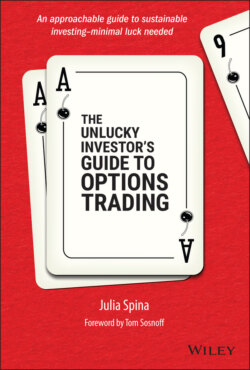Читать книгу The Unlucky Investor's Guide to Options Trading - Julia Spina - Страница 11
Foreword
ОглавлениеI've come a long way from my knuckle‐dragging pit trading days of the 1980s and 1990s. I take the wrapper off hot dogs when I eat them now, and I have also learned a few things about investing after 20 years of meeting people all over the country and teaching them how to trade. One crazy takeaway: Unlucky investors usually make the best traders. Why? Because anyone can get lucky and profit from a random investment, but in the small world of successful traders, the common denominator is quantitative skill. Another crazy takeaway: Anyone can learn these skills with access to the right information.
Way back when TD Ameritrade bought thinkorswim in 2009, I negotiated with every bit of leverage I had to personally keep the domain name, tastytrade.com. I had purchased the web address for $9.95 years earlier through GoDaddy, and I was convinced, just as I was with thinkorswim, that the name tastytrade would work. I have no idea why I loved tastytrade.com, but sometimes hunches just seem to work out. tastytrade's raison d'être was to fill the void in the financial media and offer up an untested, goodwill model built around raw, math‐based content. We've spent the last 10 years obsessively building client engagement by introducing complex financial strategies to retail investors. We still answer questions 24 hours a day and teach lessons from what we learned as market makers and software entrepreneurs: all for free. We truly are the guest who won't leave, but we believe that nonstop client engagement is core to motivating traders.
I have so many special memories from the last two decades, but one of my favorites was a strange trading story from an early 2001 trip to the desert. It was the first time we did a live trading show in Las Vegas, and a big trader at the event asked me how long it would take to get a fill on a large order using our platform. When I asked for his order, the client told me he wanted 10,000 spreads. This was before electronic spread executions existed, and I figured he was bullshitting me. But, as a show of good faith (and because I didn't want to back down), I told him we'd fill the order within one second. The client was convinced it wasn't going to happen, so I was pretty pleased when I told him, hand signal and all, that his order was filled in less than a second and the price improved by a nickel. We made asses of ourselves, but this is how it all began. Over the years, we continued to form unbreakable relationships with hundreds of thousands of amazing friends, traders, and investors. We gambled together, ate dinner together, had drinks at the bar, laughed when we made money, and cried when we lost money. We told jokes, embarrassed ourselves, humbled each other, and tortured our friends. We focused on building those relationships not only because it was a blast but because we also really saw how it motivated people to learn how to trade and participate in the market. It was key to the success of thinkorswim, and it inspired the founding of tastytrade.
When we started tastytrade, our proving ground was an old hip‐hop studio in downtown Chicago. It was a third‐floor walk‐up with a piano as the receptionist's desk and a drum set in the middle of the living room. Old album covers and broken musical instruments were everywhere, yet the energy was undeniable. Our research team consisted of a Guitar Hero champion in a hot dog suit, a few interns, and an ex‐market maker. Our mentor was a sports shock jock whose claim to fame was having sex on the 50‐yard line at Soldier Field, and to top it all off, we had hired a bunch of random comedians from Chicago's famed Second City. Thank God we knew how to trade because we had no clue how to do media. Even worse, I will never forget the day we decided to do HD quality video. I thought, “No way is that what I look like.” That's why tastytrade is so awesome because we figured out a totally new model of financial media when the odds were against us.
Lucky investors never figure things out because they never have to: They simply follow the herd and hope for the best. We refused to follow traditional financial media down the path of self‐promotion and financial irrelevance. We found smart people, fed them cheap lunches, made them work crazy hours, gave them free snacks, and mostly let them do their own thing. The result? We changed the world of strategic investing.
We knew early on that a book about options trading would add a new layer to our model of engagement and be a powerful tool for creating financial content. Eighteen years ago, I locked myself in our old conference room with one of our cofounders, and we tried to write a book. We hired a professional writer, cleared our schedules, and made the book a priority. Three days later and one and half pages in, we fired the writer and quit the book project to protect our friendship and the future of our firm. Fast forward to early 2021, and I was again bitten by the book bug, but this time, I knew I wasn't up to the task. I asked, as nicely as I am capable of, for two of our young, smart researchers to help. I said, “It's all yours.” Julia and Anton accepted the challenge, and they totally nailed it. I truly believe this is the most logical, informative, and comprehensive book on strategic options trading ever compiled. Unlucky investors can rejoice. No book will ever be a one‐size‐fits‐all holy grail for options trading, but The Unlucky Investor's Guide to Options Trading is the closest thing we have.
Tom Sosnoff
